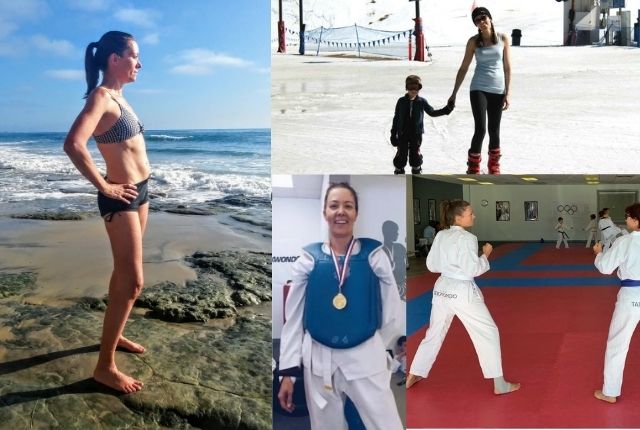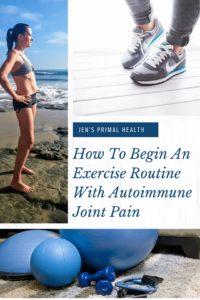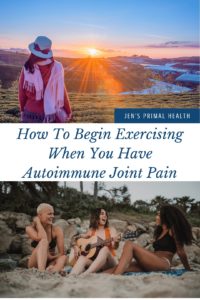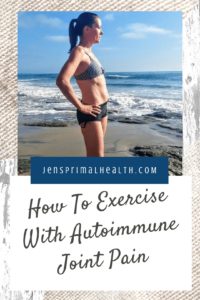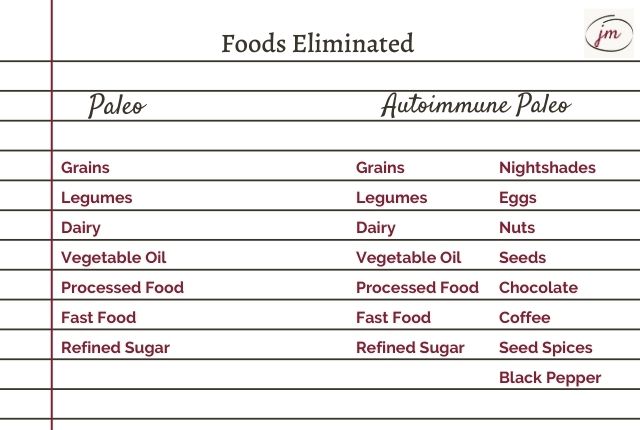I earn a small commission via affilate links at no extra cost to you.
When weighing your exercise options for autoimmune joint pain I believe the most important factor to pay attention to is how you feel. We live in a world where no pain, no gain is celebrated and it really shouldn’t be. That approach to health and fitness isn’t good for anyone, even if you don’t have autoimmune joint pain. In our youth, we played sports, or at least enjoyed physical activities, even if they could only be classified as play. Autoimmunity is on the rise yet I know there are many like myself who want to age gracefully and want to enjoy life on their terms. I get it. I’ve had days where it hurt to walk around my house barefoot. There have been days when I couldn’t make a fist and my elbow felt like it would explode while holding a pot to wash. Now I’m a 45-year-old bow hunting mom who takes Taekwondo classes 2-3 nights a week. It is possible to find a form of exercise for your joint pain.
Years ago it was believed that a person with joint pain or other maladie should stay in bed. The problem is that a lack of movement can make joint pain worse. There is hope, the body’s default programming is to heal itself. When you break a bone or cut your skin your body works to repair it. The issue with autoimmune joint pain that is often overlooked is gut health and food sensitivities. I’ve spent years working out which foods work for me and those that don’t. When I do the things that I know will prevent joint pain I don’t have joint pain. If you’ve never heard of such a thing you likely think I’m crazy but in my paleo world, there are countless people who have been able to greatly reduce and/or eliminate autoimmune joint pain.
The First Step To Addressing Autoimmune Joint Pain
A wise first step to addressing autoimmune joint pain is your diet. The less inflammation circulating in your body and reduced autoimmune reactions the better your joints will feel. As your joints begin to feel better you’ll naturally be able to do more exercise. Remember the leaky gut I mentioned above? Leaky gut precedes autoimmune joint pain. It doesn’t matter what kind of autoimmune joint pain you have, figuring out your diet is a huge piece to exercising with joint pain. How do you figure out which foods work for you and which ones don’t?
My advice is to start with the basics. The number one food group that anyone with autoimmunity is least likely to tolerate is nightshades. (Blog Post: Plant Compounds That Can Cause Joint Pain) <- That’s a pretty big list. In the beginning, don’t let it overwhelm you. You may or may not have issues with lectins and oxalates so don’t worry about those right off the bat.
My next suggestion is to give up the things that no one should be eating: artificial colors, flavors, preservatives, sweeteners, and vegetable oil. (Blog Post: Paleo For Beginners – Step 1) When you have that dialed in move on to Step 2 where you remove wheat and grains. (Blog Post: 12 Reasons To Go Grain Free) The reason I suggest going in steps is that if you’re coming from the Standard American Diet (SAD) to a paleo, autoimmune paleo, keto, or carnivore approach and you make a 180 degree turn you’re not going to have a good time. You’d essentially cut off the fuel source your body is currently running on and dramatically ask it to remember how to use another. This is why people get the carb flu. You can make the sudden jump but it kind of sucks and I don’t know many people who are motivated by the suck.
I must also emphasize the importance of working with a physician who will work with you, especially if you’re taking prescription medications. A move to eating a whole food paleo-ish diet is naturally lower in carbohydrates (inherently making it less inflammatory). When you begin eating fewer carbohydrates your blood sugar, insulin, and other hormones will begin to shift. (Blog Post: Take Back Your Hormones)
As you gradually go paleo (my recommended starting place) give it a consistent effort. Try to string together a few weeks and see how much things improve. For some, this may be enough. Others may need to take it a step further and transition to autoimmune paleo. Some people find relief with autoimmune paleo but then there are others like myself who find that it isn’t enough. Honestly, the foods your body ultimately tolerates depends on what autoimmune issue you have and your current gut health. Food sensitivity testing can get you headed in the right direction but an elimination diet is truly the best indicator. From my own personal experience, I think the lectins and vegetables, oxalates, and fiber are simply too much irritation for those of us with sensitive guts. (Blog Post: Carnivore for Rheumatoid Arthritis)
How To Incorporate Gentle Exercise For Joint Pain
I bet you were wondering when I was going to get to the exercise options eh? Sorry, I had to tackle the food component first because it’s been such a huge factor for me and my joint pain. My food choices ultimately determine what I can do, the kinds of exercise I can do, and definitely how I’ll feel after exercise. Think about it. Your diet is either inflammatory or anti-inflammatory. When you eat an anti-inflammatory diet it’s like popping a pain pill, except there’s no pill.
Considering exercise options for joint pain begin with low-impact exercises. When you’re just getting back into exercise begin with simply walking or swimming. Going for an evening stroll is actually great exercise if you want to burn body fat. Walking combined with a primal lifestyle is a simple way to begin losing body fat. Excess body weight creates stress on the joints so if you’re struggling with stubborn weight and joint pain it’s my #1 tip.
General daily movement should make up the bulk of your exercise routine and walking is a huge component of that. From the primal health perspective, our ancient ancestors didn’t have to run hard 60 minutes a day to maintain their physique. Even then, whatever exercise option you choose the purpose of exercise is longevity. When you decide on an exercise option for yourself keep track of the distance or the time spent performing that activity. Whichever you choose to measure doesn’t really matter. The important thing to notice is how far/long did you go and how does it make your body feel? If you walk for 10 minutes on flat ground and end up feeling horrible for the next 3 days then I’d suggest water-based exercise until your muscles and joints are stronger.
Water gives you weightlessness that takes a significant amount of pressure off of the joints. I know the YMCA is fairly inexpensive for a drop-in swim without a membership. If you’re concerned that excess body weight is contributing to your joint pain check out this blog post on Exercise and Fat Loss. Maybe you’re not much of a swimmer but you find that riding a bike or a gentle yoga class like yin yoga works. The point isn’t to focus on what you can’t do, focus on what you can do.
Incorporating Weight Training Exercise
Muscle mass is a predictor of longevity so this is a goal to work towards. Does that mean that you need to rack the weights with the big guys at the gym today? No. Start where you are and begin gradually. Exercises using bodyweight are a great exercise option because they can be adapted for all levels of fitness. If you can’t do a push-up on the floor, do a push-up on the wall. When wall push-ups become easy, try doing them with your hands on the kitchen counter, then a chair or a bench that won’t move. For those who are like me and can’t do a pull-up, I use my son’s playset or a bar at the park where my feet remain on the ground. That way I can use my legs to help my arms do the work.
Always begin slowly with a few exercises, see how your body responds, and then adjust accordingly. If you find that you tolerate bodyweight exercises (pull-ups, push-ups, plank, and squats) then move on to light weights or resistance bands. With time, and not forcing your body before it’s ready, you should find that your body is able to gradually handle more physical effort. Maybe your wrist and elbow pain prevents you from doing a plank. Have you ever tried crunches on an exercise ball? The ball is soft compared to the hard floor but because you’re on a ball I find that it’s more intense. Most exercises are adaptable for various levels of fitness and range of motion. Your number one job is to listen to your body. If something feels like it’s too much then it likely is right now. Look into alternative exercise options that you can do right now. Don’t get frustrated by what you can’t do. With time and patience, your future self will be surprised at what you can do.
If you read the word squats above and thought “no way” then you’re probably not alone. They’re challenging for a number of people with joint pain issues. I don’t typically have knee pain unless I’ve eating something ridiculous like nightshades, sugar, or grains. If you have back pain, knee pain, hip pain, ankle, or foot pain definitely take it easy on squats. I don’t have the structure to do an “ass to grass” squat, but really all you need is a slight bend of the knee to activate the muscles and joints. Always be mindful of proper alignment. Your toes should point forward and the knee should be in line with the second toe. The knee shouldn’t go past the ankle and your knees shouldn’t collapse inward or bow outward. Even if you can’t do a mini squat there are other exercises you can do to strengthen the thighs and legs. If you’re an ultimate beginner an exercise option for squats is to do mini squats while holding on to a pole or doorway around your house.
When I first joined the gym a few years ago 40 pounds was comfortable for me on the leg extension machine. Sure I initially felt post-exercise joint pain for a day or two afterward. It wasn’t horrible but I definitely felt that I did something I hadn’t done in a while. One thing you want to be certain to do is to make sure the leg extension machine is set up to fit you perfectly. That’s true for any gym equipment. You don’t want to put any unnecessary strain on your joints. If you’re not sure simply ask the gym staff to help you.
The key is listening to your body. If you’re still feeling a bit of joint discomfort from your last exercise session then definitely don’t pursue any difficult stuff. Stick to walking, putting your feet up, an Epsom salt bath, and a focus on quality sleep until you feel better. With time I found that my body could tolerate more weight and I no longer felt sore after lifting. Even though 30 minutes of weight lifting once a week is my average amount of gym time I’m now up to 120 pounds on that leg extension machine.
When you apply exercise stress to the body that isn’t overly taxing and you give your body time to rest and recover you’ll find that your body will rebuild itself stronger, that’s what it’s designed to do. Your job is to find what works, tune in to what your body tells you, and throw that no pain, no gain nonsense out the window. Give your body the space and resources it needs to strengthen.
Using Weights At The Gym When You’re A Woman
I feel a need to address this because I know many women are uncomfortable in the free weights area of the gym. This area is typically full of dudes and for some reason that puts many women off. I’m fortunate I guess because my college boyfriend and I used to lift weights together. Back then I simply got used to hanging out in that area. Today when I go to the gym I don’t go to the cardio machines (typically full of women); I go straight for the weights. No one has ever asked me to leave, made a rude comment, or given me their opinion about my workout. I suspect earbuds help keep the conversation to a minimum.
If you feel uneasy about the weights section ask to work with a trainer or join a gym that is exclusive to women. When I’m there I typically see a handful of women handling weights. If you’re not sure about something don’t hesitate to ask one of us. Granted I nerd out this stuff, but I know I’d love it if someone wanted to pick my brain at the gym. Those who are worried about who’s watching, what they’re thinking, are you doing it right, do you look like a fool, etc… Just remember “If they don’t like it they don’t have to look.” 😉 You do you! <3
Would you be interested in a specific workout routine from me? I’ve been kicking around some ideas. What kind of exercise routine are you looking for/need help with?
Originally posted on March 5, 2020 @ 13:21

